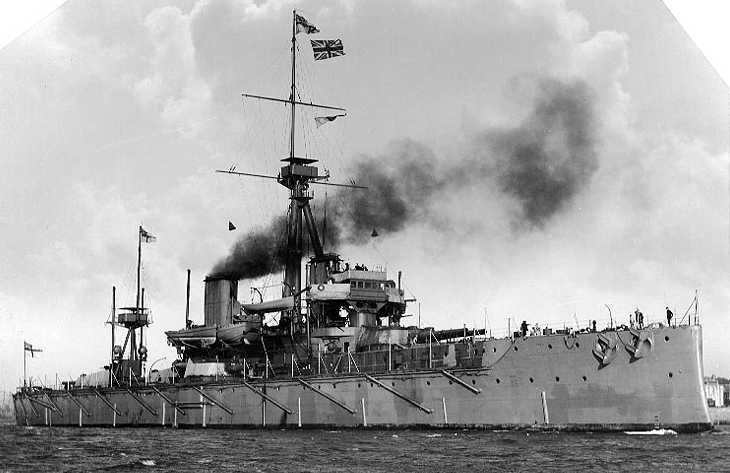| Notes:
1) The BVIII* mountings on the Indefatigable
class differed in that the gunshields were of modified shape and structure
in an effort to improve protection. The BIX and BX mountings on Invincible
were interesting in that they were electrically powered by 200 Vdc from
four 200 kW steam generators and 100 kW oil motor/generators within the
ship. These mountings proved unsatisfactory and were constantly breaking
down during their active service life. As a result, they were converted
to all hydraulic power prior to the start of World War I.
2) These mountings were reworked during
World War I to increase their maximum elevations to +16 degrees, a rather
costly operation for the small increase in range thus achieved, which was
less than 1,600 yards (1,460 m) at new gun velocities.
3) The Invincible class had staggered amidships
mountings intended to allow them to shoot across the ship as well as directly
forward and directly aft. However, gunnery trials showed that the
blast damage from such firings was unacceptable and the actual firing arcs
were restricted to approximately the figures given above. At the
Falklands battle, Invincible fired cross-deck with both P and Q turret
but this dazed and deafened the gun-layers, trainers and sight setters
as well as causing blast damage to the deck. P turret reported that
the trainers had to be replaced constantly during the battle as they were
too dazed to function properly. After the battle, cross-deck firing
was ruled out except in cases of emergency.
4) These mountings differed from earlier
ones in that projectiles and propellants were rammed directly from the
main hoisting cage into the gunloading cage without tipping out into an
intermediate position. This made for a simpler transfer but slowed
the loading cycle as the main cage could not descend until the transfer
had taken place.
5) Surviving battlecruisers had 1" (2.54
cm) armor plates added to their turret roofs following Jutland (Skagerrak).
6) Battle experience showed that British
turrets in general were inadequately protected, especially on these early
12" (30.5 cm) models. Problems included the lack of gunport shields,
which meant that splinters and blast could easily penetrate into the working
areas. There were also large gaps between the base of the gunhouse
and the top of the barbette, leaving an area of reduced protection.
The sighting ports on top of the turrets were of an open design, which
allowed both gunsmoke and sea spray to enter into the gunhouse as well
as causing considerable discomfit to the crewmembers whose job it was to
peer through these ports at the target. These sighting ports and
the turret rangefinders also projected up above the turret roof, which
unintentionally turned them into deadly shell traps. Finally, the
sloping front roof of these turrets meant that the angle of incidence for
incoming shells was less than that for a flat roof, which increased the
chance of a penetrating hit. |
